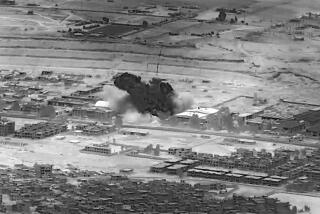White House suspects Syria used chemical weapons, seeks inquiry
WASHINGTON — The White House said for the first time that there was evidence Syria had used chemical weapons in its civil war, but administration officials called for a broader United Nations investigation and edged away from declaring Damascus had crossed a “red line” that might trigger U.S. intervention.
According to a White House letter to Congress, U.S. intelligence agencies assessed “with varying degrees of confidence” that President Bashar Assad’s forces had used small amounts of sarin gas, a deadly nerve agent banned by international treaty.
The finding was based in part on analysis of “physiological samples,” apparently referring to hair and blood from victims.
President Obama publicly warned Syria last year that use or transfer to terrorists of lethal chemical agents would prompt an unspecified U.S. response.
As recently as March 21, Obama said: “I’ve made it clear to Bashar al-Assad and all who follow his orders: We will not tolerate the use of chemical weapons against the Syrian people, or the transfer of those weapons to terrorists. The world is watching; we will hold you accountable.”
But a senior White House official said Thursday that the administration was still evaluating the evidence. The official said uncertainties in the intelligence, including whether anyone tampered with the samples, do not provide absolute assurance that Syria used the poison gas.
Sarin symptoms
People exposed to odorless, colorless and tasteless sarin by contaminated air, food, water or surfaces may experience some or all of the following symptoms:
| Head: Excessive sweating, confusion, drowsiness, headache, loss of consciousness |
| Eyes: Watery eyes, pinpoint pupils, eye pain, blurred vision |
| Nose: Runny nose |
| Mouth: Drooling, coughing |
| Chest: Tightness, rapid breathing, respiratory failure |
| Heart: Slow or fast heart rate, low or high blood pressure |
| Stomach: Nausea, vomiting, abdominal pain |
| Groin: Increased urination, diarrhea |
| Legs: Weakness, paralysis, convulsions |
Source: Centers for Disease Control and Prevention
Graphics reporting by Brady MacDonald
“We believe it’s necessary to continue to investigate — to corroborate that information and to have a strong, firm evidentiary basis … as to whether or not the red line has been crossed and to inform our decision-making about what to do next,” the official said.
The official refused to say where or when U.S. intelligence had obtained the samples. But they apparently were not gathered by U.S. personnel in the war zone.
“The chain of custody is not clear, so we cannot confirm how the exposure occurred and under what conditions,” said the official, who briefed reporters on condition of anonymity.
Still, the announcement marked a shift for the administration, which said Wednesday that it had not yet determined if evidence supported allegations by Britain, France and Israel of possible gas attacks in Syria.
Rebel groups and the Assad government have traded accusations about three alleged uses of poison gas: in Homs in December, and in Aleppo and outside Damascus, Syria’s two largest cities, in March.
Videos released by both sides purported to show dead farm animals and people struggling to breathe, but the authenticity of the footage could not be verified.
The U.S. caution reflects deep concern at the White House about being drawn militarily into the 2-year-old conflict, which has killed an estimated 70,000 people, created more than 1 million refugees and shown no sign of abating.
By insisting on proof beyond what the CIA and other U.S. agencies can provide, the administration sought to draw a clear contrast with President George W. Bush’s decision to invade Iraq in 2003. At the time, the White House cited U.S. intelligence reports about Iraqi weapons of mass destruction that proved wildly inaccurate.
“We have seen very bad movies before, when intelligence is perceived to have driven policy decisions that in the cold light of day have proven wrong,” said a senior U.S. defense official.
But Obama risks appearing as though he is seeking an excuse to stay on the sidelines. Critics say the White House should do more to stop Syrian use of unconventional weapons and to safeguard U.S. interests in the Middle East as radical fighters take a larger role in the insurgency.
Some senior Democrats called Thursday for stronger action.
“It is clear that red lines have been crossed and action must be taken to prevent larger-scale use,” said Sen. Dianne Feinstein (D-Calif.), head of the Senate Intelligence Committee. “The world must come together to prevent this by unified action which results in the secure containment of Syria’s significant stockpile of chemical weapons.”
Republicans expressed doubts about turning to the United Nations.
“I am deeply concerned with reports that further confirmation of use may be outsourced to the United Nations,” said House Speaker John A. Boehner of Ohio. “If Assad sees any equivocation on the red line, it will embolden his regime.”
U.S. authorities say Damascus has more than 1,000 tons of chemical agents, including sarin and VX, another deadly nerve gas. U.S. officials believe Assad’s forces still control the arsenal, although they have moved some stockpiles to keep them from rebel forces. Partly for that reason, U.S. officials said Thursday, any attacks using chemical agents are likely to have been carried out by government forces.
U.S. officials confirmed after the Homs attack that they were trying to gather witness statements, soil samples, and blood and hair from victims, which could contain chemical residues.
In January, U.S. diplomats in Turkey cabled Washington that Assad’s forces probably used poison gas in Homs, citing interviews with opposition activists, doctors and defectors, according to a report on the Foreign Policy magazine website. U.S. officials later confirmed the account.
U.S. experts also detected trace chemicals in soil samples. “The problem is we don’t know where the physical evidence came from,” a U.S. official said. “It was given to us by another [spy] service.”
U.N. Secretary-General Ban Ki-moon appointed a panel in mid-March to investigate the three alleged attacks, but the inquiry has stalled because Syria has refused to provide the “unfettered access” investigators seek. Assad has little reason to cooperate, so the team’s ability to collect fresh evidence is doubtful.
A State Department spokesman, Patrick Ventrell, said that if the U.N. researchers can’t visit the sites, “we’ll continue to look at this through other avenues as well.”
The White House letter says simply that the administration is “pressing for a comprehensive [U.N.] investigation.” Officials have not said whether the administration will turn to the U.N. Security Council for a resolution calling on Assad to comply.
A U.N. blessing may be difficult to achieve. Russia has cited Assad’s claims that rebels used chemical weapons. North Atlantic Treaty Organization allies, who supported military intervention in Libya in 2011, are deeply reluctant to get involved even in planning a military response in Syria.
The Pentagon has prepared military options to secure the stockpiles, and last week Defense Secretary Chuck Hagel announced that 200 Army troops would go to neighboring Jordan to assist in the planning. But Army Gen. Martin Dempsey, chairman of the Joint Chiefs of Staff, openly opposes a military response, which one Pentagon study said could require as many as 70,000 troops.
Hagel, whose first visit to the Middle East as Defense secretary this week was dominated by discussions of Syria, acknowledged Thursday in Abu Dhabi, United Arab Emirates, that confirmation of chemical weapons use would dramatically raise international stakes in the war.
“It violates every convention of warfare,” Hagel said. “Most people in the world, most leaders put the use of chemical weapons in a different category.”
Times staff writers Cloud reported from Washington and Bengali from Abu Dhabi. Staff writers Paul Richter and Ken Dilanian in Washington contributed to this report.
More to Read
Sign up for Essential California
The most important California stories and recommendations in your inbox every morning.
You may occasionally receive promotional content from the Los Angeles Times.












